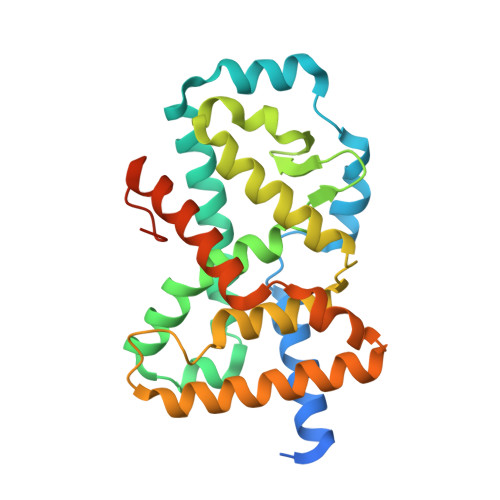Identification of bicyclic hexafluoroisopropyl alcohol sulfonamides as retinoic acid receptor-related orphan receptor gamma (ROR gamma /RORc) inverse agonists. Employing structure-based drug design to improve pregnane X receptor (PXR) selectivity.
Gong, H., Weinstein, D.S., Lu, Z., Duan, J.J., Stachura, S., Haque, L., Karmakar, A., Hemagiri, H., Raut, D.K., Gupta, A.K., Khan, J., Camac, D., Sack, J.S., Pudzianowski, A., Wu, D.R., Yarde, M., Shen, D.R., Borowski, V., Xie, J.H., Sun, H., D'Arienzo, C., Dabros, M., Galella, M.A., Wang, F., Weigelt, C.A., Zhao, Q., Foster, W., Somerville, J.E., Salter-Cid, L.M., Barrish, J.C., Carter, P.H., Dhar, T.G.M.(2018) Bioorg Med Chem Lett 28: 85-93
- PubMed: 29233651
- DOI: https://doi.org/10.1016/j.bmcl.2017.12.006
- Primary Citation of Related Structures:
6BN6, 6BNS - PubMed Abstract:
We disclose the optimization of a high throughput screening hit to yield benzothiazine and tetrahydroquinoline sulfonamides as potent RORγt inverse agonists. However, a majority of these compounds showed potent activity against pregnane X receptor (PXR) and modest activity against liver X receptor α (LXRα). Structure-based drug design (SBDD) led to the identification of benzothiazine and tetrahydroquinoline sulfonamide analogs which completely dialed out LXRα activity and were less potent at PXR. Pharmacodynamic (PD) data for compound 35 in an IL-23 induced IL-17 mouse model is discussed along with the implications of a high Y max in the PXR assay for long term preclinical pharmacokinetic (PK) studies.
Organizational Affiliation:
Bristol-Myers Squibb, Research and Development, Princeton, NJ 08543-4000, United States.
















